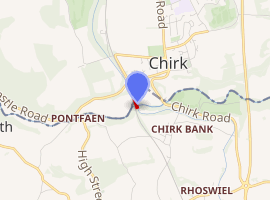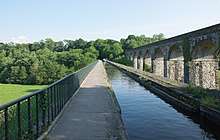Chirk Aqueduct
Chirk Aqueduct is a 70-foot (21 m) high and 710-foot (220 m) long navigable aqueduct that carries what is now the Llangollen Canal across the Ceiriog Valley near Chirk, on the England-Wales border, spanning the two countries.
Chirk Aqueduct | |
|---|---|
Chirk Aqueduct and the railway viaduct behind it | |
| Coordinates | 52.9282°N 3.0622°W |
| OS grid reference | |
| Carries | Llangollen Canal |
| Crosses | Ceiriog Valley |
| Locale | Chirk |
| Maintained by | British Waterways |
| Characteristics | |
| Trough construction | Cast iron |
| Pier construction | Masonry |
| Total length | 710 feet (220 m) |
| Height | 70 feet (21 m) |
| Traversable? | Yes |
| Towpaths | East Side |
| No. of spans | Ten |
| History | |
| Designer | Thomas Telford |
| Construction end | 1801 |

| |
History
The aqueduct was designed by civil engineer Thomas Telford[1] for the Ellesmere Canal. The resident engineer was M. Davidson who also acted as resident engineer on a number of Telford's other works.[1] The foundation stone was laid on 17 June 1796 and it was completed in 1801.[2] It has a cast iron trough within which the water is contained. The masonry walls hide the cast iron interior. The aqueduct followed Telford's innovative Longdon-on-Tern Aqueduct on the Shrewsbury Canal, and was a forerunner of the Pontcysyllte Aqueduct, also on the Llangollen Canal.[3] The aqueduct was briefly the tallest navigable one ever built, and it now is Grade II* listed in both England and Wales.[4][5] It forms part of the Pontcysyllte Aqueduct World Heritage Site.[5]
Description

The aqueduct consists of ten arches, each with a span of 40 feet (12 m). The water level is 65 feet (20 m) above the ground and 70 feet (21 m) above the River Ceiriog.[2] The stone work is yellow sandstone.[5] William Hazledine provided the ironwork for the aqueduct.[6] Originally built with iron plates only at the base of the trough, iron side plates were added to the aqueduct in 1870 to alleviate leakage.[7][8]
The Chirk Tunnel starts at the north end of the Chirk Aqueduct, allowing the canal to continue on towards Llangollen.[5] A railway viaduct was built later alongside the aqueduct. It is slightly higher than the aqueduct.[8]
References
- Glover, Julien (2017). Man of Iron - Thomas Telford and the Building of Britain. London: Bloomsbury. p. 383.
- Samuel Smiles (2004). The Life of Thomas Telford. Kessinger Publishing. ISBN 1-4191-6991-2.
- Samuel Smiles (1861). Lives of the Engineers, with an Account of Their Principal Works. J. Murray.
- Historic England. "Chirk Aqueduct (Grade II*) (1295150)". National Heritage List for England. Retrieved 5 November 2015.
- Chirk Conservation Area: Draft Character Assessment & Management Plan (PDF). Wrexham.gov.uk. June 2014. Retrieved 7 April 2016.
- A. W. Skempton (2002). A Biographical Dictionary of Civil Engineers in Great Britain and Ireland. Thomas Telford. ISBN 0-7277-2939-X.
- Roger Cragg (1997). Wales and West Central England: Wales and West Central England, 2nd Edition. Thomas Telford. ISBN 0-7277-2576-9.
- Quenby, Ron (1992). Thomas Telford's Aqueducts on the Shropshire Union Canal. Swan Hill Press. ISBN 1-8531-0246-6.
External links
| Wikimedia Commons has media related to Chirk Aqueduct. |
- Chirk Aqueduct at chirk.com
- 360 Degree Panoramic View at BBC Shropshire (Java Applet Required)